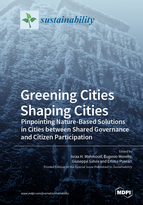Greening Cities Shaping Cities: Pinpointing Nature-Based Solutions in Cities between Shared Governance and Citizen Participation
A special issue of Sustainability (ISSN 2071-1050). This special issue belongs to the section "Sustainable Urban and Rural Development".
Deadline for manuscript submissions: closed (31 January 2022) | Viewed by 83166
Special Issue Editors
Interests: nature-based solutions; co-creation; urban greening; shared governance
Interests: urban sustainability; climate planning; urban planning and design; co-creation; urban greening
Special Issues, Collections and Topics in MDPI journals
Interests: participatory and co-design; sustainable production and consumption; systemic thinking
Special Issues, Collections and Topics in MDPI journals
Interests: urban innovation; urban public service innovation and governance; urban sustainability transition; urban design and civic initiatives; urban planning and design
Special Issue Information
Dear Colleagues,
The topic of pinpointing nature-based solutions (NBS) in the urban context has lately been attracting interest from different scholars, urban planning practitioners, and policymakers. This Special Issue originates from the Greening Cities Shaping Cities Symposium held at the Politecnico di Milano (12–13 October 2020), aiming at bridging the gap between science and practice of getting NBS implemented in the built environment. In particular, we invite scholars to investigate how NBS and urban greening strategies are re-shaping the built environment and the whole imagery of cities, both from a spatial and a governance perspective. This Special Issue welcomes scientific articles that cover novel insights into urban debates on design and planning theory, policy, and practice around NBS. Currently, cities are making use of nature as a solution to many challenges, without radically and critically addressing the full potential of interpreting green as a powerful urban design and governance feature. For instance, how will vegetation infilling strategies affect the planners’ toolkit and decision-making procedures? How can we get citizens involved in the design and management process around NBS?
We invite authors to address the procedural gaps in strategies for greening cities that are currently at the forefront of the re-shaping of many urban fabrics. Specifically, we aim to investigate the following aspects:
Governance: A strong emphasis on NBS viability for implementation often encounters hindrances on the governance scale and lacks a strong functional governance model to “make it work”. A big tranche of this pitfall is due to the lack of capacity and communication between municipality departments and each other, as well as the need to raise awareness on how the NBS operate in day-to-day activity. Hence, capacity building and awareness activities are a major need in city decision-making processes to make NBS implementation more inclusive and managerially shared. Citizen participation: NBS are living and dynamic systems and require specific attention in design and maintenance. Hence, the engagement and active role of citizens is crucial. One important aspect of innovation in NBS implementation is its inclusivity and its relatedness to citizen-centered approaches for implementation in urban living labs (ULL). ULLs allow a flexible structural pathway and include a variety of sleeve tools to bring everyone on board. Lessons in this section would mainly address the successful case studies from physical or digital ULLs experiences of implementing NBS in urban regeneration processes.
Hence, the major question we posed is whether the embeddedness of NBS in cities tangibly affects urban morphologies and radically impacts our approach to urban planning and design strategies and urban governance. Integrating nature and NBS seems to be happening more and more frequently in city strategic planning and visions; however, there seems to be a lack of deeper and conscious debate concerning the recognition of the role of greening in shaping the overall imagery of cities and renovating the role of green as a quintessential element of design and planning.
This Special Issue will touch base on many aspects related to NBS conceptualization, implementation, and upscaling in cities. Finally, work that helps to understand and interpret how greening cities is affecting urban shaping, both from a morphological and governance point of view, is also welcome.
Dr Israa H. Mahmoud
Prof. Dr. Eugenio Morello
Dr. Giuseppe Salvia
Dr. Emma Puerari
Guest Editors
Manuscript Submission Information
Manuscripts should be submitted online at www.mdpi.com by registering and logging in to this website. Once you are registered, click here to go to the submission form. Manuscripts can be submitted until the deadline. All submissions that pass pre-check are peer-reviewed. Accepted papers will be published continuously in the journal (as soon as accepted) and will be listed together on the special issue website. Research articles, review articles as well as short communications are invited. For planned papers, a title and short abstract (about 100 words) can be sent to the Editorial Office for announcement on this website.
Submitted manuscripts should not have been published previously, nor be under consideration for publication elsewhere (except conference proceedings papers). All manuscripts are thoroughly refereed through a single-blind peer-review process. A guide for authors and other relevant information for submission of manuscripts is available on the Instructions for Authors page. Sustainability is an international peer-reviewed open access semimonthly journal published by MDPI.
Please visit the Instructions for Authors page before submitting a manuscript. The Article Processing Charge (APC) for publication in this open access journal is 2400 CHF (Swiss Francs). Submitted papers should be well formatted and use good English. Authors may use MDPI's English editing service prior to publication or during author revisions.
Keywords
- nature-based solutions
- greening cities
- shaping cities
- co-creation
- shared governance









